| Pages:
1
2
3 |
copperastic
Hazard to Others
  
Posts: 158
Registered: 15-3-2014
Location: In your basement
Member Is Offline
Mood: Good
|
|
Aga Sodium and chlorine doesn't involve oxygen or hydrogen.
|
|
|
aga
Forum Drunkard
    
Posts: 7030
Registered: 25-3-2014
Member Is Offline
|
|
Well, The_Davster, i tend to agree, despite me knowing just about nothing.
I say that because the Gibbs calculations will certainly have come from observed reactions rather than Divine Knowledge.
All such derived formulae have definite Limits.
To rely on derived data, and Only do experiments on such derived equations places a Limit on what was originally oddballs mixing stuff up and seeing
what happens.
Simply repeating their Cutting Edge research and deriving formulae isn't quite the same, but i feel that understanding the maths is valuable.
Personally i'll do the 'see what happens', but i'd like some understanding as well.
|
|
|
aga
Forum Drunkard
    
Posts: 7030
Registered: 25-3-2014
Member Is Offline
|
|
Well said Space Traveller.
|
|
|
Zyklon-A
International Hazard
    
Posts: 1547
Registered: 26-11-2013
Member Is Offline
Mood: Fluorine radical
|
|
I don't have access to a camera at the moment, but my fan looks like this:
Also, I couldn't find a link for the exact one I have either, but if you look at Home Depot, you should find one for a good price.
[Edited on 28-3-2014 by Zyklonb]
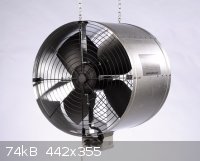
|
|
|
blogfast25
International Hazard
    
Posts: 10562
Registered: 3-2-2008
Location: Neverland
Member Is Offline
Mood: No Mood
|
|
@aga:
The thermodynamics of the reaction are important to work out whether or not a planned reaction can proceed or not (but it says NOTHING about practical
conditions in which it may succeed).
Time and time again beginners come up with schemes that CAN'T fly because they simply aren't thermodynamically viable (ΔG > 0, cannot
proceed).
For instance, a few days ago someone suggested to use zinc to reduce SiO2, acc.:
SiO<sub>2</sub> + 2 Zn === > Si + 2 ZnO
Well, this reaction is strongly endoenergetic (ΔG > 0) and zinc cannot reduce silicon dioxide.
We'll gradually teach you how to make these calculations, just don't get too hung up on it for now. Trust me: it's much simpler than you imagine.
[Edited on 28-3-2014 by blogfast25]
|
|
|
MrHomeScientist
International Hazard
    
Posts: 1806
Registered: 24-10-2010
Location: Flerovium
Member Is Offline
Mood: No Mood
|
|
Quote: Originally posted by aga  | | Now i seem to have some of my copper back, and a layer of Purest Brown Sludge which i'll filter and taste, and hopefully call Al2SO3.
|
I really hope you don't actually plan to taste anything you make in the lab. That's about the worst thing you could do.
The brown sludge is fine copper powder - filter, dry, and store it for future use! The fact that the solution lost all its blue color means that you
reacted (nearly) all of the copper sulfate into copper metal and aluminum sulfate. Al2(SO4)3 is fairly soluble, so
will likely remain in solution with the quantities you're using. Probably a good idea to rinse your copper powder with water a few times to wash away
any impurities.
I'll second the recommendation to get a bigger exhaust fan for your hood. That little PC fan won't be able to handle smoke/fumes from a reaction gone
out of hand, which is when you need it most. Try making a small potassium nitrate & sugar smoke bomb and setting it off in the hood and watch what
happens. Besides a bigger fan, one that is explosion-proof is also a necessity if you ever plan on working with flammable vapors. A baffle system
along the back wall will help to direct both heavy and light gases into the exhaust duct. There's lots of threads on fume hood construction around
here, so search around.
Also a note of caution: you use a lot of words like "randomly" and "OCD" combining of chemicals. This is not the way to approach chemistry, and can
get you into some serious trouble. You've always got to be careful, and plan things out thoroughly beforehand. When I do an experiment, I write down
the equation for the reaction I'm trying and think about any possible side reactions that can happen. Plan for gas evolution, temperature rise/fall,
hazardous byproducts, etc. all before you step into the lab.
Don't get me wrong - it's great that you're so enthusiastic about chemistry! Just try to temper your excitement with some forethought and caution.
Chemistry is tons of fun, and can be done safely as long as you respect your chemicals.
|
|
|
blogfast25
International Hazard
    
Posts: 10562
Registered: 3-2-2008
Location: Neverland
Member Is Offline
Mood: No Mood
|
|
Yes, safety first. Chemistry can be a seriously volatile mistress!
Try starting with A-level experiments, many of which can be found on the net and which come with complete, idiot proof instructions, including safety
guidelines. They tend to be highly educational and totally safe. After that you can become 'creative'.
|
|
|
aga
Forum Drunkard
    
Posts: 7030
Registered: 25-3-2014
Member Is Offline
|
|
@Señor Blogfast25
SiO2 + 2 Zn === > Si + 2 ZnO
Gibbs says it can't work (at STP at least)
Please demonstrate, using the Gibbs formulae, why it will not.
You will be educating, and can credit yourself with explaining the Gibbs Comobulation to me at least.
@MrHomeScientist
Naturally my toungue will not be involved in the tasting.
Cheers for the explanation of what i made, and what to do with it.
Please explain how this is known : "Al2(SO4)3 is fairly soluble"
Is there a calculation that can predict that ?
Safety is my prime concern, as i am not dedicated enough to discover how sulphuric acid Feels in my eyes.
That's why i made a 'safe area' before i started, and use thick gloves and a full face visor (goggles feel bad, and glasses-type protectors feel too
insecure).
Side note : Red Cabbage juice works as a broad spectrum pH indicator.
I whizzed some up with hot water, filtered it and then squirted it into all sorts of solutions.
Goes different colours nicely, relative to pH.
Apparently a Package has arrived at the P.O., so inwards and spinwise !
|
|
|
blogfast25
International Hazard
    
Posts: 10562
Registered: 3-2-2008
Location: Neverland
Member Is Offline
Mood: No Mood
|
|
@aga:
To calculate the Gibbs Free Energy of a hypothetical reaction we use Hess’ Law. Hess’ Law declares that Gibbs Free Energy is a so-called State
Function. If we go from State 1 (the left hand side of the equation) to State 2 (the right hand side of the equation) then it doesn’t matter how we
get from left to right: the change in Gibbs Free Energy (ΔG) is always the same and path-independent.
This provides calculators with a handy device: just break down the reaction into ‘sub reactions’ for which ΔG (or ΔH, depending on which
you want to calculate) are known and then simply add them up. In the case of the SiO2 + Zn reaction:
Sub reaction 1: SiO2 → Si + O2
This is the opposite of the formation reaction of SiO2 and has the same value but the opposite sign: ΔH = + 905.5 kJ/mol. This value comes from
the NIST Webbook.
Sub reaction 2: Zn + ½ O2 → ZnO
This is the formation reaction of ZnO and its value for ΔH = - 350.5 kJ/mol (also NIST Webook)
Now if we add up 1 of Sub reaction 1 and 2 of Sub reaction 2, we have indeed our original reaction.
Hess then allows to simply add the ΔH values, so that for the original reaction we obtain:
ΔH = + 905.5 + 2 x ( - 350.5) = + 204.5 kJ/mol, so: strongly endothermic.
I could have used values for ΔG instead but didn’t have them at hand. Values for ΔH and ΔG for countless simple reactions can be
found in a myriad of tables and books and can be used to construct paths that correspond to reactions one want to explore.
[Edited on 28-3-2014 by blogfast25]
|
|
|
aga
Forum Drunkard
    
Posts: 7030
Registered: 25-3-2014
Member Is Offline
|
|
Thanks blogfast25.
I remember that Sodium fizzes about on water, so that must be a reaction with a -ve Gibbs value.
Seems the reaction is 2Na + 2H2O -> 2NaOH + H2 and the ΔH is -368.6kJ
(found in the workings of an example discovered by googling)
So, as the ΔH is -ve, this reaction will take place with no external energy input.
Somehow i failed to get the Reaction Search NIST page to work.
Using 'sodium' or 'Na' in the reactants fields always says 'no data available'.
What should i be typing in to find the thermochemical data for this particular reaction ?
I expect the ΔH for Ca + H2O will be a bigger (absolute) -ve number, as i remember a 10 litre glass bowl of water shattering when a blob of Ca
was added.
Is there a 'threshold' ΔH at which a reaction is considered dangerous, as in it could well go pop ?
|
|
|
MrHomeScientist
International Hazard
    
Posts: 1806
Registered: 24-10-2010
Location: Flerovium
Member Is Offline
Mood: No Mood
|
|
For solubilities, the wiki solubility table is a handy resource: http://en.wikipedia.org/wiki/Solubility_table
It's got a lot of holes, and some entries have been proven to be incorrect by people on this forum, but for the most part it's a great place to start.
| Quote: | | I expect the ΔH for Ca + H2O will be a bigger (absolute) -ve number, as i remember a 10 litre glass bowl of water shattering when a blob of Ca
was added. |
Calcium is much less reactive than sodium. It will fizz vigorously when added to water, but won't come close to being explosive whereas sodium often
can. If it was indeed calcium that shattered a bowl, I'd guess it was from the heat generated thermally shocking the glass.
|
|
|
blogfast25
International Hazard
    
Posts: 10562
Registered: 3-2-2008
Location: Neverland
Member Is Offline
Mood: No Mood
|
|
NIST webbook, try this page:
http://webbook.nist.gov/chemistry/name-ser.html
Insert a VALID chemical formula in the box and tick 'Condensed phase', then press 'Search'. If available for your choice of compound the Standard Heat
(Enthalpy) of Formation will show up, along with other thermochemical data (that shouldn't concern you right now). Note that conventionally the Heats
of Formation of pure, uncompounded elements is set at 0 kJ/mol.
As regards your example, depending on the data you used, it may be correct only for formation of solid NaOH, not a solution of NaOH. In the real world
when Na reacts with water a solution of NaOH is formed. We notate this as:
Na(s) + H<sub>2</sub>O(l) === > NaOH(aq) + 1/2 H<sub>2</sub>(g)
...where the bracket indicates s = solid, l = liquid, g = gas, aq = watery solution.
If you intended to find the value for NaOH(aq) then the relevant values must be used for NaOH(aq), not NaOH(s).
The point you make about calcium is an example of how NOT to make empirical observations and conclusions: w/o knowing for instance just how much Ca
was used it is impossible to draw any valid conclusions re. Delta H. To make a comparison with Na, identical quantities would have to be used in
otherwise also identical conditions. It's the oldest rule in the book: 'to observe a change objectively, only change one thing at a time'.
Much of science is the 'art' of observation and by default we're not good at it due to all kinds of factors that want to fool our brain. As you go
along you should get better at observing things carefully and objectively.
[Edited on 29-3-2014 by blogfast25]
|
|
|
aga
Forum Drunkard
    
Posts: 7030
Registered: 25-3-2014
Member Is Offline
|
|
Excellent !
Thanks very much for the pointers folks.
It's really good to start to see part of the Mountain of stuff to learn.
I am probably wrong about the Ca mentioned above.
Could well have been something else much more reactive.
The lasting memory was the look on the chem teacher's face as large volumes of water cascaded all over the place, while a madly fizzing, fuming and
burning blob of stuff skated around in the puddle on the floor.
|
|
|
blogfast25
International Hazard
    
Posts: 10562
Registered: 3-2-2008
Location: Neverland
Member Is Offline
Mood: No Mood
|
|
Quote: Originally posted by aga  | | The lasting memory was the look on the chem teacher's face as large volumes of water cascaded all over the place, while a madly fizzing, fuming and
burning blob of stuff skated around in the puddle on the floor. |
Another chem demonstrator who didn't know what he was doing. Demos are notoriously difficult to carry off without carefully prepping/rehearsing.
|
|
|
Chemistry_Keegan
Harmless

Posts: 45
Registered: 16-2-2013
Location: Nova Scotia
Member Is Offline
Mood: Interested
|
|
You may be thinking of cesium. Cesium is an alkaline metal, which is the first group on the periodic table, with the exception of hydrogen. Sodium is
also in that group, and as you go down it, the metals react more and more violently with water. The only one that has never been tested is francium,
because it is so radioactive that it is too difficult and dangerous to produce significant quantities of. Presumably, it would react even more
violently then cesium, but that is still under debate. Take a look at this video:
http://www.youtube.com/watch?v=uixxJtJPVXk
|
|
|
blogfast25
International Hazard
    
Posts: 10562
Registered: 3-2-2008
Location: Neverland
Member Is Offline
Mood: No Mood
|
|
One thing that would be interesting to do is to make this comparison in the absence of air (oxygen), as it would prevent the hydrogen from catching
fire. Here the comparison, however interesting, is skewed because we are effectively observing two reactions at once (at least from K downwards):
M(s) + H<sub>2</sub>O(s) === > M<sup>+</sup>(aq) + OH<sup>-</sup>(aq) + 1/2 H<sub>2</sub>(g)
And H<sub>2</sub>(g) + 1/2 O<sub>2</sub>(g) === > H<sub>2</sub>O(g)
That makes the K, Rb and Cs reactions 'unfairly' more energetic.
[Edited on 29-3-2014 by blogfast25]
|
|
|
aga
Forum Drunkard
    
Posts: 7030
Registered: 25-3-2014
Member Is Offline
|
|
Haaaaahahahahaa !
Cheers Chemistry_Keegan
That video is *exactly* as i remember what happened, including the big glass bowl, and it's fate !
I think it was sodium first, then cesium.
|
|
|
aga
Forum Drunkard
    
Posts: 7030
Registered: 25-3-2014
Member Is Offline
|
|
Well, given the large quantity of copper (II) sulphate, i took up the suggestion to make Tetraamminecopper(II) sulfate.
It was a dismal failure.
Reading the bottles, my Ammonia is 3%, and full of soap.
My CuSO4(aq) is of an unidentified concentration (it hasn't crystallised yet)
The alcohol i used just said 'Alcohol' on it, so could be anything.
On squirting the 'Ammonia' into the CuSO4(aq), the solution formed a dark purple layer at the top, but this dissipated really fast, especially after
stirring.
So, given that OTC Ammonia is weak, but still smells of ammonia, i think it should be feasible to heat it a bit, and bubble the gas thru some water.
Repeat (maybe endlessly) to arrive at a much higher conc. ammonia.
Thanks to the useful link to solubility tables, i assume that the NH3 will dissolve happily in the receiving water, making a higher % solution
(eventually).
Question: is there anything i can add to the OTC ammonia to evolve the actual NH3(g) faster, rather than heating ?
[Edited on 29-3-2014 by aga]
|
|
|
Texium
Administrator
       
Posts: 4580
Registered: 11-1-2014
Location: Salt Lake City
Member Is Online
Mood: PhD candidate!
|
|
I purified some OTC ammonia using a distillation apparatus, and that worked very well. Mine came in a high enough concentration, I just needed to
remove the surfactants, so boiling the ammonia and water together actually worked for me.
|
|
|
aga
Forum Drunkard
    
Posts: 7030
Registered: 25-3-2014
Member Is Offline
|
|
A side note on Jars :
It seems to me that used food jars are the cheapest way to get glass jars.
The best (as in VFM) are pulses (lentils, beans etc) for Big jars, and paté for small jars.
Naturally you can eat the pulses, but i had one sniff at the paté and then the dogs cleaned the jars very thoroughly indeed.
The Lid Seal is a concern : i'm not sure what it is, and so have no idea if it is apt for storage of some things.
Other Side note on Hot Plates :
I ordered a cheap single-ring 230vac hot plate off ebay.
Certainly it will have a simple thermostat, which will be a bit pants in terms of temperature accuracy.
Seems that i have about 100 thyristors and opto-isolators from a previous project, so i think i'll do a circuit to control the heating more precisely.
If it works out OK, i'll happily share the design.
|
|
|
blogfast25
International Hazard
    
Posts: 10562
Registered: 3-2-2008
Location: Neverland
Member Is Offline
Mood: No Mood
|
|
Aga:
Household ammonia is typically only about 4 w% and doesn't work for the copper ammonia complex (although you could try with a really weak solution of
CuSO4).
You can make a much stronger NH3 solution by reacting any ammonium salt (cheap garden grade (NH4)2SO4 for instance) with a strong alkali like NaOH:
(NH4)2SO4(s) + 2 NaOH(s) === > Na2SO4(s) + 2 NH3(g)
Capture the gas by leading it into clean water in which it is amazingly soluble. I did this some years ago and the gas didn't in fact bubble, instead
at the outlet into the water one single bubble formed and the NH3 diffused directly from there into the water through the surface of the bubble.
There's a thread on it somewhere here.
Maximum concentration that can be achieved is 33 w% (density of 0.9 g/ml).
For permanent storage of chemicals jars aren't really recommended, although it depends what it is you're storing.
Electrical hot plates are usually accurate enough for most purposes. Thyristors can be used to control tubular furnaces or mantle heaters, where
better control can be an advantage.
[Edited on 30-3-2014 by blogfast25]
|
|
|
Fantasma4500
International Hazard
    
Posts: 1681
Registered: 12-12-2012
Location: Dysrope (aka europe)
Member Is Offline
Mood: dangerously practical
|
|
this thing is insanely useful
http://www.trimen.pl/witek/calculators/stezenia.html
another useful tool: stay entirely objective
for boiling down liquids you can put a computer fan connected to old phone charger on top of the beaker, dragging the air out of the beaker
i yet have to try and add a fan to solution on a large glass pan, i recall i reduced several litres of water within a few hours on a glass pan, the
kind you use for frying food in the oven
also.. aluminium foil is quite useful especially if working with HNO3, if you have a beaker thats entirely round without any 'tap' or similar you can
make it perfectly airproof with abit of skill
|
|
|
aga
Forum Drunkard
    
Posts: 7030
Registered: 25-3-2014
Member Is Offline
|
|
Quote: Originally posted by Antiswat  |
for boiling down liquids you can put a computer fan connected to old phone charger on top of the beaker, dragging the air out of the beaker
|
Superb ! What an excellent idea.
|
|
|
aga
Forum Drunkard
    
Posts: 7030
Registered: 25-3-2014
Member Is Offline
|
|
Wow !
Just 1 year on and got half a clue what i'm doing and have chlorinated sulphur on a whim ...
Here's how the 'lab' has grown over the year :-
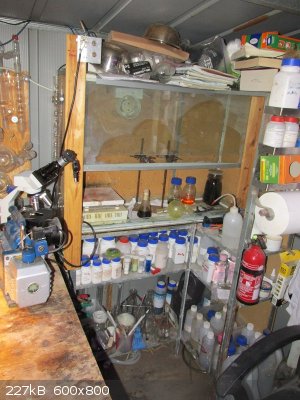
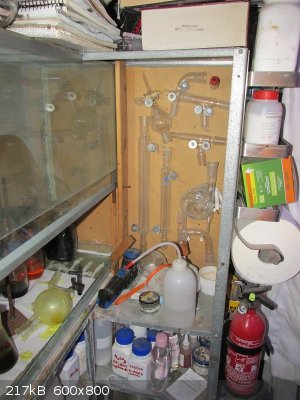
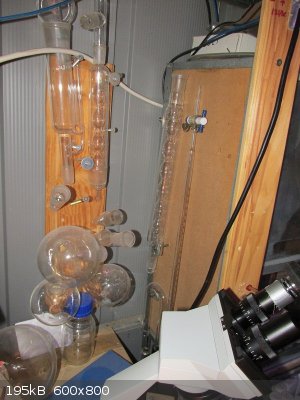
As more and more stuff arrived i had to get inventive with the severely limited space, so glassware decorates the hardboard side walls.
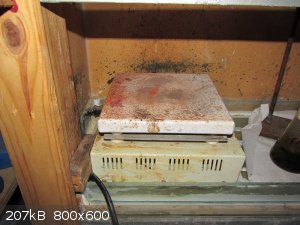
That hotplate has seen some action !
|
|
|
blogfast25
International Hazard
    
Posts: 10562
Registered: 3-2-2008
Location: Neverland
Member Is Offline
Mood: No Mood
|
|
Better than mine in some respects. Don't store flammable materials on top of your fume hood though! 
|
|
|
| Pages:
1
2
3 |